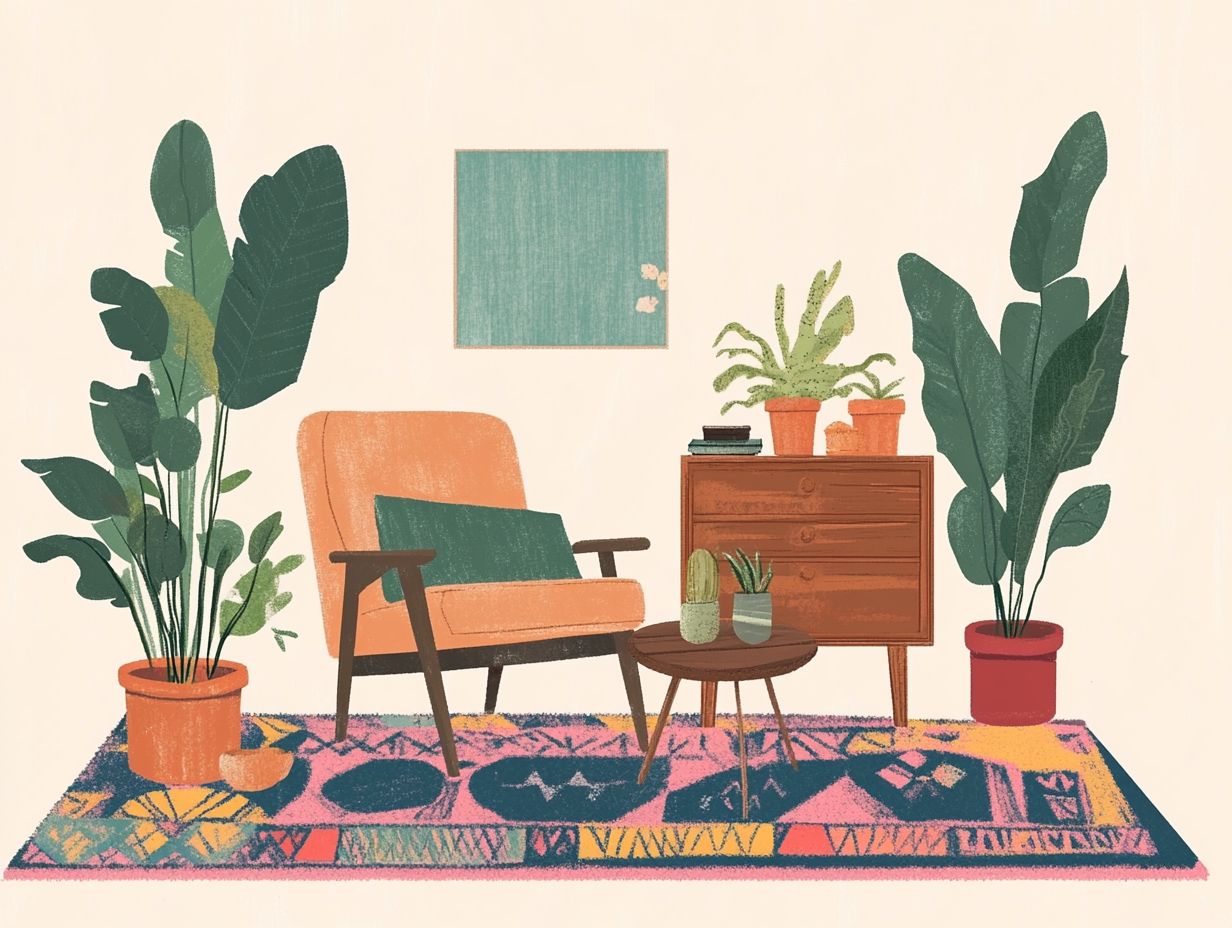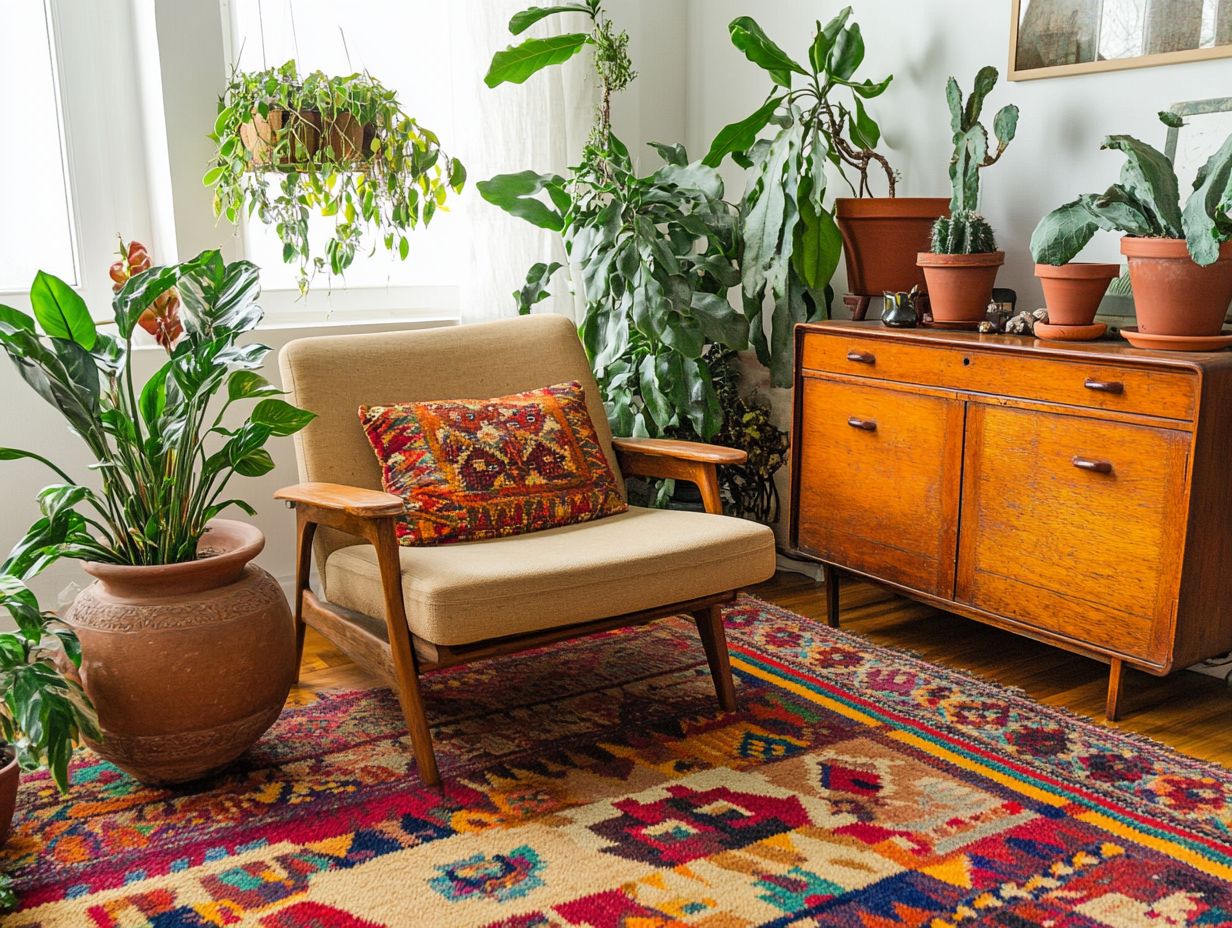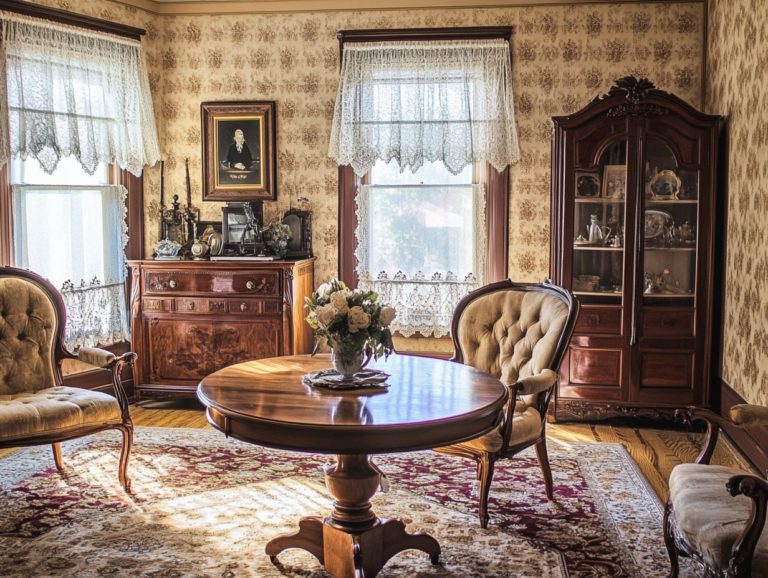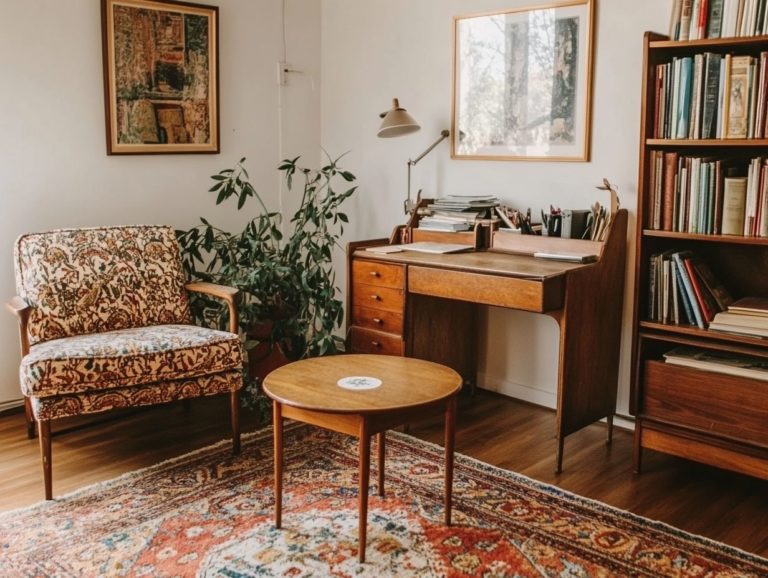The Impact of Vintage Furniture on Interior Design
Vintage furniture possesses a distinctive charm that transcends time, infusing character and warmth into any space you inhabit.
Its rich history and growing prominence in contemporary interior design make vintage pieces not only beautiful but also sustainable choices.
In this article, you’ll delve into the origins of vintage furniture, learn tips for integrating it into modern settings, explore its impact on design trends, and discover essential care techniques to preserve its beauty.
Embark on a journey to find authentic pieces that will enrich your home with timeless elegance.
Contents
- Key Takeaways:
- The History of Vintage Furniture
- Why Everyone Loves Vintage Furniture Today!
- Incorporating Vintage Furniture in Modern Spaces
- The Impact of Vintage Furniture on Interior Design Trends
- Caring for and Maintaining Vintage Furniture
- Where to Find Quality Vintage Furniture
- Frequently Asked Questions
- What is vintage furniture?
- How does vintage furniture impact interior design?
- What are some popular vintage furniture pieces in interior design?
- What are the benefits of incorporating vintage furniture in interior design?
- How do you balance vintage furniture with modern design and minimalist decor?
- Where can I find vintage furniture for my interior design project?
Key Takeaways:

Vintage furniture adds a unique look to interior design with its rich history and evolving styles.
Incorporating vintage furniture in modern spaces adds character and promotes sustainability.
Taking care of vintage furniture helps keep its charm and value intact for years to come.
The History of Vintage Furniture
The history of vintage furniture is a fascinating tapestry woven from the threads of historical periods like Victorian, Arts and Crafts, and Art Deco. This journey reveals not just the evolution of design but also a legacy of craftsmanship that continues to shape modern trends.
As you explore vintage pieces, you’ll discover their unique character and enduring influence on home decor and interior design. From their original creation to their revival today, the timeless charm of vintage furniture embodies timeless style and exceptional craftsmanship, appealing to both collectors and enthusiasts.
Origins and Evolution
The origins of vintage furniture can be traced back through various eras that have profoundly shaped its evolution. The Victorian era celebrated ornate designs and exquisite craftsmanship.
During this time, skilled artisans took immense pride in their work, crafting pieces that served practical purposes while also acting as status symbols that reflected the wealth and refined tastes of their owners.
Going further back, the Renaissance era introduced intricate carvings and rich materials, establishing a standard of quality and artistry that resonates within modern aesthetics.
Meanwhile, the minimalist influences of the Bauhaus movement challenged traditional norms by advocating for functional simplicity that modern designers continue to explore.
Each historical period uniquely contributes to what we now recognize as vintage furniture, illustrating how craftsmanship has interwoven diverse styles that enrich contemporary interiors. Understanding the role of vintage furniture in eco-friendly homes further enhances our appreciation of these timeless pieces.
Why Everyone Loves Vintage Furniture Today!
Vintage furniture has seen a remarkable rise in popularity among interior designers and discerning homeowners, largely due to its unique beauty and the increasing focus on sustainable decor. As you explore environmentally friendly choices for your space, vintage pieces naturally emerge as a favored option, aligning beautifully with your values.
Unique Aesthetic Appeal
The unique beauty of vintage furniture lies in its remarkable ability to blend seamlessly with diverse design styles, making it a versatile choice for your home decor. Its character and charm infuse your space with personality, allowing you to cultivate an inviting atmosphere steeped in history and storytelling.
Vintage pieces often act as captivating conversation starters, effortlessly drawing your guests in with their unique designs and the fascinating tales they carry. This kind of furniture enhances the visual allure of a room and contributes to a thoughtfully curated collection that reflects your personal style and taste.
By integrating these timeless items, you create inviting spaces that foster meaningful connections and spark memorable discussions.
Sustainability and Eco-Friendliness

In today s world, embracing vintage furniture offers you a sustainable decor option that beautifully aligns with eco-conscious living.
By choosing pre-loved pieces, you help create a circular economy. This choice reduces waste and extends the lifecycle of materials.
This burgeoning trend in sustainable consumption stands as a powerful counter to the throwaway culture that fuels pollution. It champions the idea that high-quality, well-crafted items can be cherished as timeless treasures.
The environmental benefits are noteworthy. They include minimizing carbon footprints associated with new production, preserving forests, and alleviating landfill burdens.
Choosing vintage isn t just stylish it shows you care about the planet. It s a choice that truly reflects your values!
Incorporating Vintage Furniture in Modern Spaces
Incorporating vintage furniture into modern spaces creates a stunning juxtaposition of the past and present.
This approach crafts an inviting atmosphere that honors historical significance while embracing contemporary design preferences.
Tips for Mixing and Matching
Mixing and matching vintage furniture with modern pieces can be an artful endeavor that adds unique character and a personal touch.
To achieve that harmonious balance, consider how each item complements the overall aesthetic of your space.
Start by selecting a focal point perhaps a stunning vintage armchair or a sleek, modern coffee table around which the rest of your decor can revolve.
Utilize color palettes that bridge the gap between eras. Neutral tones can work wonders, or you might opt for a daring accent that appears in both styles.
Layering textures is another effective strategy. Pair a rustic wooden table with a sleek, contemporary lamp to enhance visual interest.
Ultimately, the key lies in allowing the distinctive charm of each piece to shine. This creates an inviting atmosphere that uniquely reflects your personal taste.
The Impact of Vintage Furniture on Interior Design Trends
The influence of vintage furniture on interior design trends is nothing short of transformative. It shapes contemporary aesthetics while simultaneously sparking a resurgence in the market for secondhand and antique pieces.
In today s furniture landscape, these timeless items not only enhance your space but also celebrate a rich history that resonates with discerning tastes.
Influential Styles and Movements
Various design movements, such as Victorian, Art Deco, and Arts and Crafts, have left a lasting impression on vintage furniture.
Victorian designs feature intricate details, such as opulent fabrics and ornate carvings. This showcases a strong appreciation for craftsmanship that appeals to collectors.
Meanwhile, Art Deco introduces striking geometric patterns and luxurious materials, embodying an era of glamour that continues to influence contemporary interiors.
The Arts and Crafts movement champions natural materials and artisanal techniques, reflecting a shared inclination towards sustainability and authenticity in design choices.
Together, these movements inform the forms and functions of vintage items while embodying the ethos behind modern design practices. They highlight a timeless appreciation for both beauty and utility.
Caring for and Maintaining Vintage Furniture

Caring for and maintaining vintage furniture demands a deep commitment to preservation and a keen understanding of restoration techniques.
By doing so, you ensure that these exquisite pieces retain their quality craftsmanship and unique character.
This allows them to be cherished for generations to come.
Now’s the time to explore vintage options for your home. Embrace the charm while making a difference!
Preservation and Restoration Techniques
Preservation and restoration techniques for vintage furniture are vital for maintaining their historical significance and exquisite craftsmanship.
By employing methods such as meticulous cleaning, humidity control, and careful refinishing, you can ensure that these treasures remain both functional and stunning. Understanding techniques like reupholstering and repairing the way pieces of wood are joined together is essential for anyone who wants to extend the life of their beloved pieces.
Adopting appropriate storage solutions and protective treatments will help prevent deterioration, safeguarding the intricate details and artistry that define vintage furniture.
These practices enhance the longevity of the items and pay homage to the craftsmanship and rich stories behind each piece.
Where to Find Quality Vintage Furniture
Embarking on the quest for quality vintage furniture and antique furniture can be an exhilarating experience. You have a wealth of options at your fingertips, from online retailers boasting exquisite selections to local furniture markets that showcase a thoughtfully curated collection of authentic treasures and handcrafted pieces.
Best Places to Shop and Resources for Authentic Pieces
Shopping for vintage furniture requires you to know the prime spots to explore, including reputable online retailers like 1stDibs and Chairish, as well as local markets that specialize in authentic pieces.
This journey opens the door to unique finds that reflect your personal style and add character to any space. Well-known online platforms like Etsy and Chairish offer curated selections, making it effortless to discover quality items from trusted sellers around the globe.
Discover amazing vintage finds at flea markets, estate sales, and various design trends that can unveil hidden treasures with rich history.
Make sure your vintage pieces are not only beautiful but also authentic and durable. When you re on the hunt for vintage items, taking the time to research the brands and their crafting methods allows you to make informed choices that will endure over time.
Frequently Asked Questions
What is vintage furniture?

Vintage furniture refers to pieces that are at least 20 years old and have a timeless appeal, often reflecting the style and trends of a specific era.
How does vintage furniture impact interior design?
Vintage furniture adds character and uniqueness to a space, creating a sense of depth and history. It can also serve as a statement piece or focal point in a room.
What are some popular vintage furniture pieces in interior design?
Some popular vintage furniture pieces include mid-century modern chairs, antique dressers, and retro coffee tables. Each of these pieces can add a touch of nostalgia and charm to any space.
What are the benefits of incorporating vintage furniture in interior design?
Aside from aesthetic value, vintage furniture is often well-made with high-quality materials, making it durable and long-lasting. It can also be more cost-effective compared to buying new furniture.
How do you balance vintage furniture with modern design and minimalist decor?
To balance vintage furniture with modern design, try mixing and matching styles and eras. For example, pair a vintage sofa with contemporary artwork or incorporate a vintage rug in a sleek, modern space.
Where can I find vintage furniture for my interior design project?
You can find vintage furniture at thrift stores, flea markets, and online vintage retailers. You can also repurpose and upcycle old furniture to give it a new life in your interior design.





